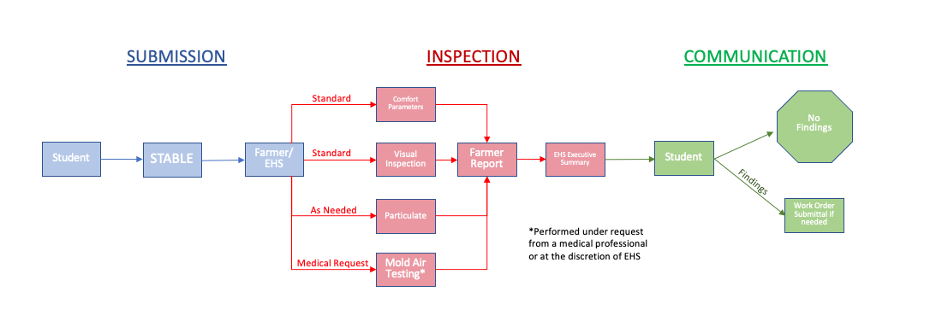Mold - Student Information
Introduction
Southern Methodist University is committed to providing an environment that is free of recognized hazards and to investigate complaints that may be related to indoor air quality (IAQ) and mold. Acceptable indoor air quality is air in which there are no known contaminants at harmful concentrations as defined by various Federal and State entities. This website outlines SMU’s response to indoor air quality and mold inquiries from students.
Compromised indoor air quality may be caused by vapors, dust generated in the work environment, materials infiltrating from outside sources (such as pollen or engine exhaust), contaminants associated with fungal growth or deficiencies in the ventilation system. Unfortunately, due to scientific limitations and variations in individual sensitivity, EHS is not always able to identify an indoor air quality problem when complaints or symptoms are reported.
Illnesses and Allergies
Illnesses related to indoor air quality or mold are very rare and symptoms are difficult to discern from other common illnesses. Most of the common symptoms are related to the eyes, nose, and throat. Most of these symptoms are also caused by seasonal allergies. North Texas has a unique allergen profile and many people that move to campus from other areas experience an onset of allergy-related symptoms. RLSH has a WellFacts informational sheet that highlights this issue. Individuals that experience these symptoms should be assessed by their physician. It is very common for people that move from western climates such as California, Nevada, and Arizona or individuals from the Northeastern United States to experience new allergy-related symptoms upon moving to North Texas. The below map illustrates this. Because of these geographical differences, it is also very common for symptoms to alleviate when students return home for holidays or summer break.
Mold Information
More information can be found specifically about mold at: https://www.smu.edu/BusinessFinance/Risk-Management/Environmental-Health-Safety/Occupational-Health/Mold
Indoor Air Quality and Mold Assessments
Students who suspect that they may have an indoor air quality issue should submit a work order through STABLE and select the “Indoor Air Quality” button.
Facilities routes any work orders related to IAQ or mold to EHS personnel and a 3rd party state-certified inspector for response.
Initial On-Site IAQ Investigation
When notified, EHS, or their representative will conduct an initial on-site investigation. The following conditions will typically be evaluated:
· Location of outside air intake(s)
· Immediate outside environment
· Operation and maintenance of HVAC system
· Relative humidity
· Temperature
· Carbon dioxide level
· Carbon monoxide level
· Signs of water intrusion
· Odors or visual indicators of a potential mold issue
EHS will also evaluate the living/work area and building for probable sources of contaminants, such as chemical use and storage; general housekeeping; recent renovations and/or new furnishings, and the building HVAC system.
In-Depth IAQ Investigation
In some cases, the initial investigation indicates the need for an additional IAQ investigation to provide more detailed information regarding the nature of the problem and MAY include any or all of the following:
· Particle assessments
· Mold air sampling – this method is not recommended by federal entities and will only be performed at the request of a licensed medical provider or at the discretion of EHS.[1]
· Air sampling for specific contaminants
· Detailed HVAC evaluations
Limitations of IAQ Investigations
Sampling methodologies and acceptable limits have been established for many contaminants. However, occupants may continue to experience discomfort at contaminant levels below standards for occupational exposure. Also, individual sensitivities vary. Sampling and measuring indoor mold contamination on surfaces is of limited value because mold is found in virtually all environments, and because no consensus or regulatory standards have been established. One of the problems with establishing standards is that individual sensitivity to mold varies greatly.
All IAQ, mold, and environmental assessments must be performed by members of EHS or consultants hired by SMU. Members of the SMU community ARE NOT allowed to bring in their own consultants.
Communication and Follow-up
EHS will prepare or receive from a 3rd party, a written report that includes investigative findings, raw sampling data, and possible conclusions and corrective actions. An Executive Summary of these findings will be shared with the complainant, their Residential Community Director, and Residential Operations Manager. The full findings WILL NOT be distributed, but are available for review in the EHS offices. The report cannot be copied or shared digitally.
Recommendations with be broken up into two categories, one for Facility-related improvements and the other for resident improvements. An example of this breakdown is below:
|
Facility-related Improvements |
Resident Responsibilities |
|
i.e. Clean HVAC vents |
i.e. Deep clean room |
|
Repair/Replace water damaged window sill |
Remove trash and food waste |
|
Replace damaged carpet |
Vacuum space |
If significant facility-related issues were identified, SMU will coordinate appropriate repairs and remediation. Upon completion of these repairs, EHS may perform follow-up investigations and testing as warranted.

[1] The National Institute for Occupational Safety and Health (NIOSH), as part of the Centers for Disease Control (CDC) recognizes that visual inspections in conjunction with musty odors are a more reliable method for correlating health risks in indoor environments. This visual inspection process is key. Because there are no established health-based standards for acceptable levels of biological agents in indoor air, it is not recommended to perform routine air sampling for mold. People have varying sensitivities to mold exposure, therefore those test results – taken as a snapshot in time – do not represent actual exposure nor can they be interpreted with regards to health risks.
Search the SMU website
Search
Did you know?
SMU's singular approach to integrating rigorous learning with hands-on experience will prepare you to achieve your educational goals and expand your world in ways you never imagined. Ours is a community of people forging their own paths. We'd like to help you shape yours.
Plan your visit